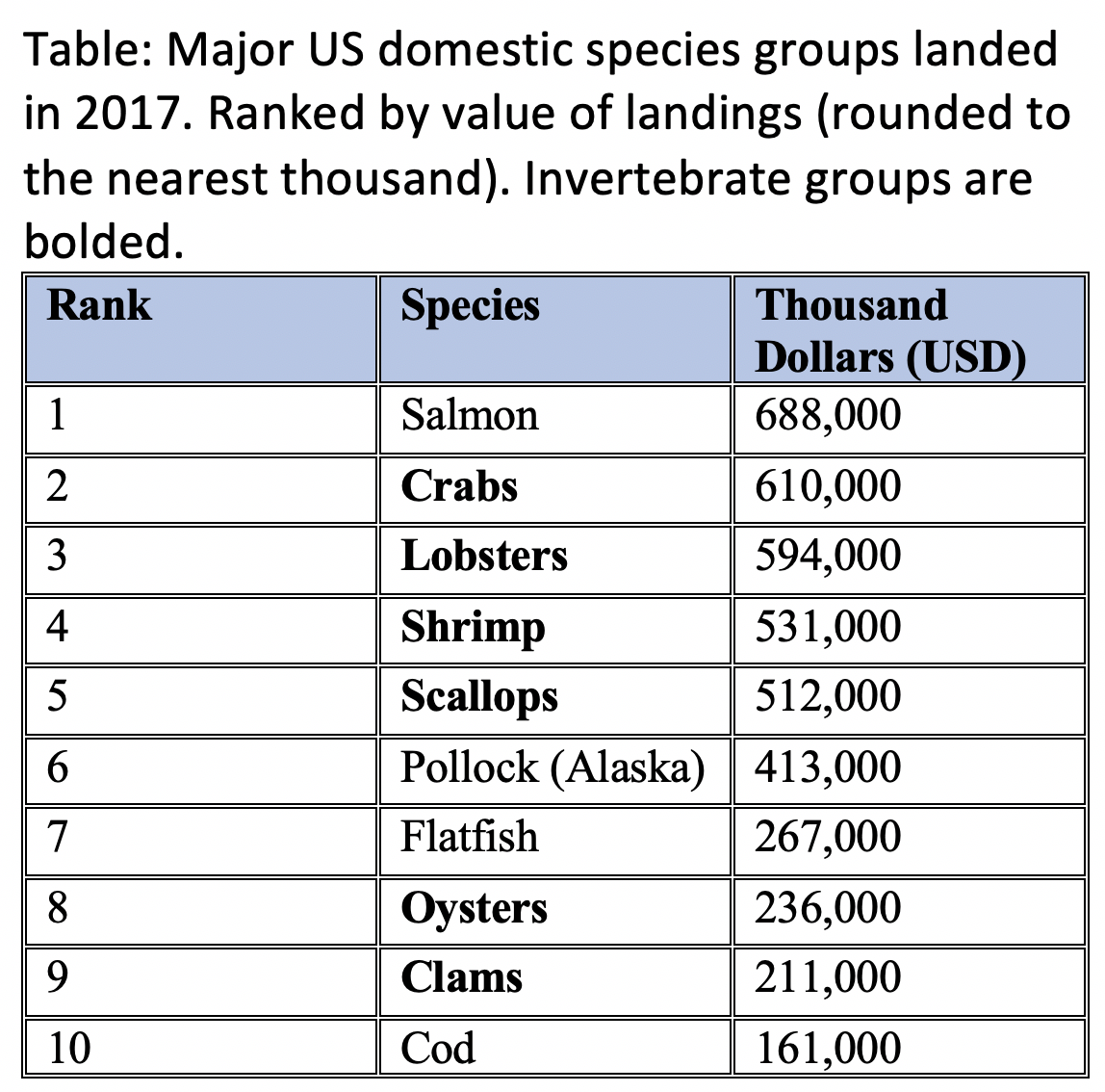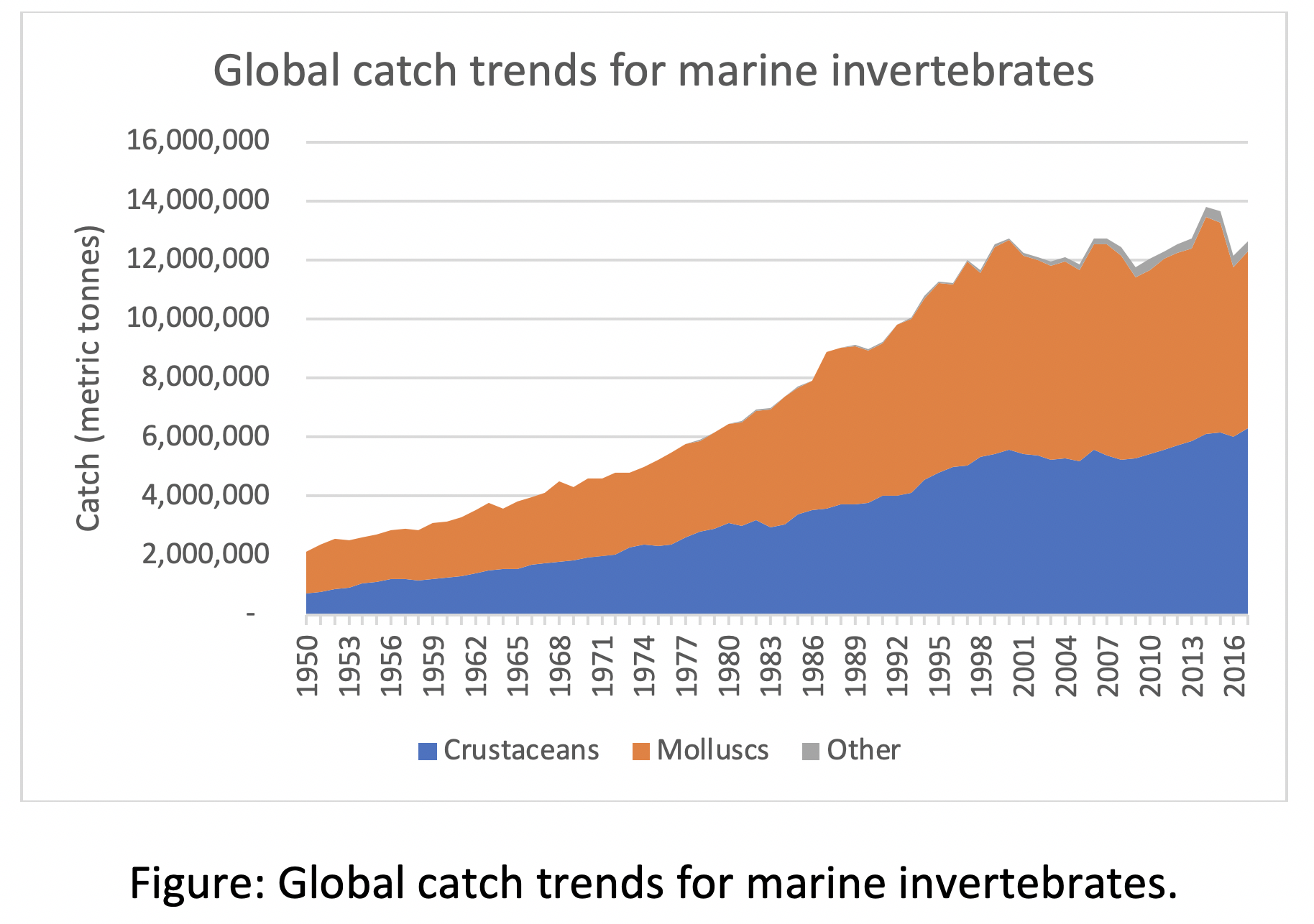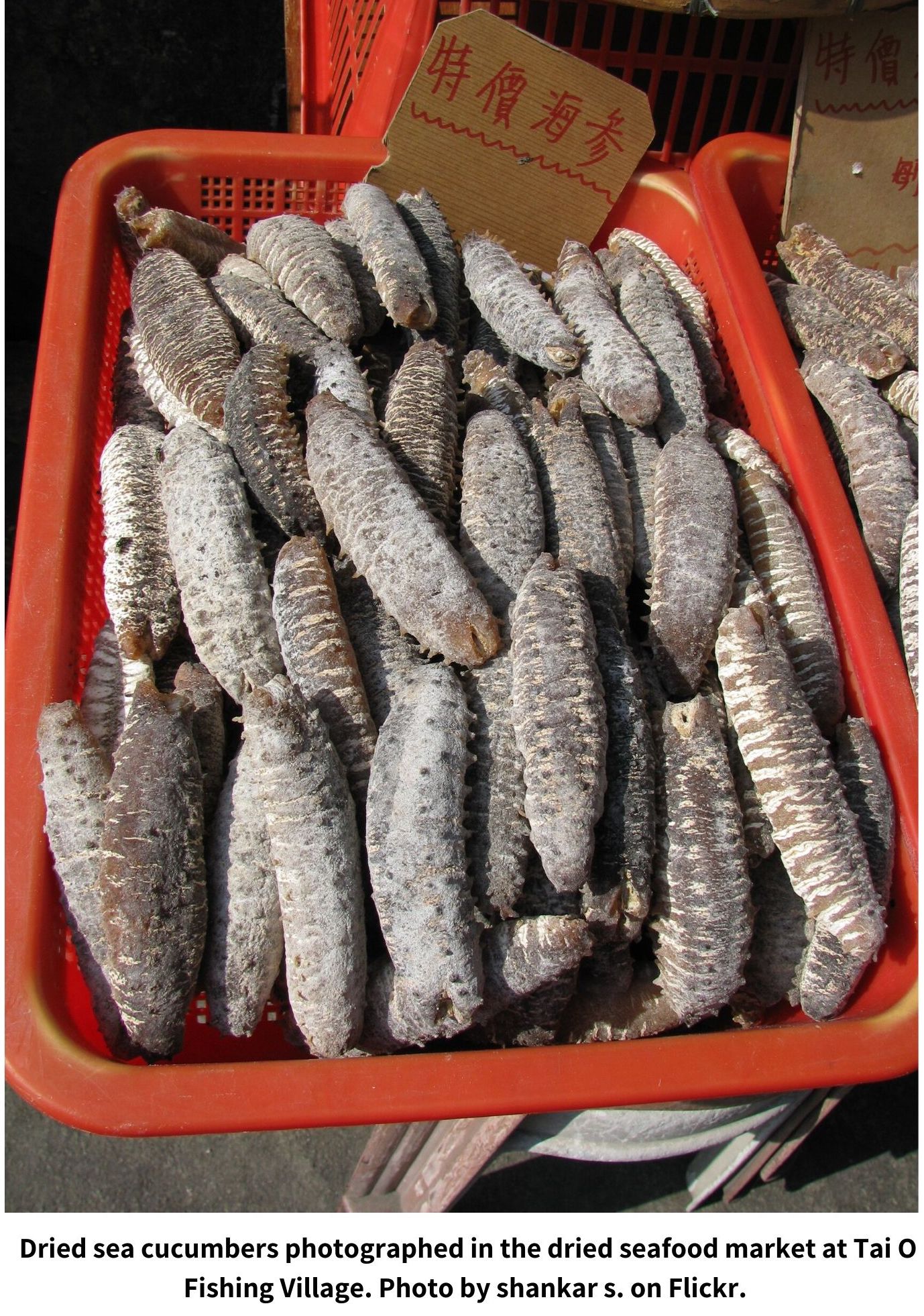Editor’s note: In 2016, roughly one-third of the total value of the world’s trade of fish and fish products was invertebrates. (They were approximately one-fifth of the global fish trade by live weight.) To learn more about the state and future of invertebrate fisheries management, The Skimmer interviewed Heike Lotze, a professor in the Department of Biology at Dalhousie University in Halifax, Canada. In this interview, we discuss several of her papers published over the past decade on the recent expansion, ecosystem effects, and management of invertebrate fisheries, including a recent synthesis “Ecosystem effects of invertebrate fisheries” published in Fish and Fisheries in 2017.
The Skimmer: As global catch of invertebrates increases, what impacts are invertebrate fisheries having on marine ecosystems?
Lotze: Invertebrate catches have increased more than six-fold globally since the 1950s. Catches include all major species groups –  from lobster, shrimp, and crabs (crustaceans) to octopus, cuttlefish and squid (cephalopods) to mussels and snails (mollusks) to sea urchins and sea cucumbers (echinoderms). In many countries, invertebrates are some of the most lucrative commercial fisheries and provide coastal communities with valuable livelihoods and associated benefits. The global increase in catches has been accompanied by the spatial expansion of invertebrate fisheries: many more countries are engaging in fishing invertebrates, and many more areas within countries are now fishing invertebrates. For example, sea urchin and sea cucumber are now fished around the globe, and fishing for invertebrates has expanded from shallow to deeper waters to maintain or enhance catch levels. Fisheries have further shifted from large- to smaller-sized individuals and from high- to lesser-valued species, usually in response to declining catches and following a ‘fishing down the value-chain’ pattern.
from lobster, shrimp, and crabs (crustaceans) to octopus, cuttlefish and squid (cephalopods) to mussels and snails (mollusks) to sea urchins and sea cucumbers (echinoderms). In many countries, invertebrates are some of the most lucrative commercial fisheries and provide coastal communities with valuable livelihoods and associated benefits. The global increase in catches has been accompanied by the spatial expansion of invertebrate fisheries: many more countries are engaging in fishing invertebrates, and many more areas within countries are now fishing invertebrates. For example, sea urchin and sea cucumber are now fished around the globe, and fishing for invertebrates has expanded from shallow to deeper waters to maintain or enhance catch levels. Fisheries have further shifted from large- to smaller-sized individuals and from high- to lesser-valued species, usually in response to declining catches and following a ‘fishing down the value-chain’ pattern.
Many people may think it is ‘just’ invertebrates, but these species play important ecological roles in marine ecosystems. These roles are often more diverse than the roles that fish play, consequently the impacts of invertebrate fisheries on other species and marine ecosystems are more varied than those of finfish fisheries. For example:
- Many invertebrates are important prey for higher trophic level species, such as fish, whales, turtles, and seabirds, and reducing invertebrate abundance can have ripple effects through marine food webs, comparable to those of forage fish;
- Many mussels, oysters, and sponges enhance biodiversity by creating three-dimensional structures that are important habitat for other species – for settlement, finding food, finding shelter, breeding, and nursery grounds;
- Many invertebrates filter feed which improves water quality and clarity and provides benefits to other organisms, including humans;
- Herbivore grazers, such as many urchins and gastropods, act as lawn mowers keeping algal carpets in check; and
- Detritivore sea stars and sea cucumbers clean up ocean floors as the scavengers of the sea.
Reducing the abundance of these species has multi-fold effects on marine ecosystem structure, functions, and services. Quantifying these is not easy because there is a general lack of field observations, surveys, and experiments. We therefore used ecosystem models for 12 marine regions around the world to better understand what effects the depletion of invertebrates may have on other species and trophic groups. In our model ecosystems, the simulated depletion of targeted invertebrates by 60% (a moderate level of fisheries depletion) in the modeled ecosystem led to:
- A 20%-change in abundance for 85% of other species;
- A 40%-change in abundance for 11% of other species; and
- A 60%-change in abundance for 5% of other species.
Not all the resulting changes were declines – the abundance of some species declined while others increased, but the changes in populations and overall structure of the modeled ecosystems were significant. Reducing the level of invertebrate depletion in our models always resulted in lower and fewer ecosystem effects.
In addition to the level of exploitation, the way we fish is also important. The majority of invertebrates (53% of catch by volume, 71% by taxa) are caught by seafloor trawling and dredging, which is known to destroy important three-dimensional habitat, disturb seafloor communities, and affect many sensitive, threatened or endangered species either directly or through bycatch. Thus, invertebrate fisheries are not less harmful than finfish fisheries, yet there is often less regulation, monitoring, and overall awareness  about them.
about them.
The Skimmer: What is the overall status of invertebrate fisheries management? Do invertebrate fisheries need to be managed any differently than finfish fisheries?
Lotze: Over the past decades, an increasing proportion of invertebrate fisheries has been considered collapsed, over-, or fully exploited. For example, about 69% of sea cucumber fisheries worldwide show signs of being over-exploited, and 81% show population declines. Also, lack of regulation and illegal fishing are important issues in about half of sea cucumber fisheries. Generally, the status of invertebrate fisheries management depends on the target species, the type of fishery, and where you are in the world. As in finfish fisheries, some high value and long-established invertebrate fisheries, such as those for lobster, are well managed and monitored in many countries. Other highly lucrative and newer fisheries, however, such as those for sea cucumbers or sea urchins, have little regulation or restrictions and are over fished – resulting in boom-and-bust fisheries that move from one country to the next, driven by global corporations and demand.
Do invertebrates need to be managed differently than finfish fisheries? The short answer is yes, but again, it depends a bit on the target species and type of fishery. For many invertebrate species, traditional stock assessment models do not always work because their biology and ecology differ from that of finfish species and requires other considerations in terms of reproductive output, growth rates, life cycle, and age of maturity, among other factors. Moreover, for many invertebrates there are no good abundance estimates or monitoring programs, so we do not know how many are out there and what their population trends are. It is often assumed that they are very abundant and not vulnerable to overfishing, the same assumption that many people had about finfish throughout history and was proven wrong by recent fish stock collapses.
In terms of actual management, the basic practices are similar to those of finfish, e.g., effort and gear regulations, catch quotas, closed areas or seasons. However, the effectiveness of these practices depends on good knowledge of the stocks and populations, their life cycle, behavior, and dynamics including response to fishing pressure. If we do not have that knowledge, management is often based on trial and error. Modeling studies show that many invertebrates are fished at levels that are too high to reach the maximum sustainable yield (MSY). Here, reducing depletion levels could result in similar or even higher catches, lower fishing costs, and lower ecosystem impacts, a win-win situation. This has been demonstrated in modeling studies for invertebrate fisheries across 12 marine ecosystems globally, as well as for individual lobster, abalone, and sea cucumber fisheries in New Zealand and lobster fisheries in Nova Scotia.
The Skimmer: Do you have any recommendations for the ecosystem-based management of invertebrate fisheries based on your and your colleagues’ research?
Lotze: Ecosystem-based management has five major pillars with the overall goal to ensure healthy, productive, and diverse marine ecosystems. These include (i) the maintenance of ecosystem characteristics to protect non-target species, vulnerable species, habitats, and trophic interactions, (ii) the protection of essential habitats to sustain species diversity and abundance, (iii) the protection of endangered, threatened, and vulnerable species, (iv) the reduction of bycatch and discards and elimination of destructive and unselective exploitation methods, and (v) the management of target species in the context of the overall state of the ecosystem, habitat, protected species, and non-target species.
All these ecosystem pillars need to be applied to invertebrate fisheries, as well as finfish fisheries. As such:
- If we want to maintain a healthy structure and functioning of marine ecosystems, exploitation levels need to be kept below those that reach MSY (not higher as currently often done), so that the ecosystem effects of fishing can be strongly reduced.
- If we want to support higher trophic levels, e.g., marine mammals, fish, birds, and turtles, we need to keep high abundance levels of marine invertebrates in the sea so that they can serve as food, habitat, water filters, and scavengers, among other roles.
- If we want to protect essential habitats, we need to reduce destructive gear, especially seafloor trawling and dredging.
- If we want to protect endangered, threatened, and vulnerable species, we need to reduce unselective gear as well as gear prone to entanglement, ghost fishing, and other harmful effects.
- And we need to manage invertebrate fisheries not on their own but in the context of other fisheries and resource uses, conservation efforts, and human impacts in marine ecosystems on local, regional, and global scales.
Finally, we need to fully recognize that as we exploit invertebrates at higher and higher levels, we risk substantially changing marine ecosystems. Invertebrates are not ‘better’ or easier to exploit than other species, they are not less important in marine ecosystems, and they are not less vulnerable to fishing or other human impacts. I hope we can enhance our awareness of this diverse group of invertebrate species, recognize the important roles they play in marine ecosystems, and manage them and their ecosystems with great care and respect.
